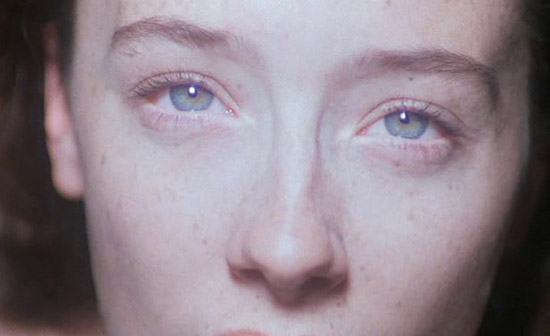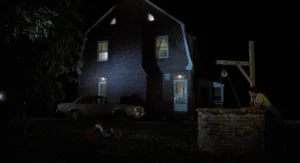![]()
Kissed (1996) Directed by Lynne Stopkewich
How can I possibly explain to anyone that this transfixing coming-of-age about necrophilia is hauntingly beautiful and yet never gross? How can I even put into words the power and metaphysical resonance it had on me as I watched in awe at such a morbid subject? I’m not even entirely sure how this transgressive art piece manages to be so without actually being transgressive. However, as many intractable questions invade my muddled thoughts and challenge the way I watch and evaluate films, I do have a lucid idea of what I felt when I watched the uncommonly bold feature debut by Canadian director Lynne Stopkewich.
While David Cronenberg’s Crash startled and outraged unsuspecting audiences and sanctimonious critics at the Cannes Film Festival with its spectacle of symphorophilia, Lynne Stopkewich’s Kissed was doing its thing at the Toronto International Film Festival with its breathlessly romantic portrayal of necrophilia. What a glorious year for the adventurous Canadian film scene. Both films deal with taboo subjects with almost the same transcendental inclinations. It is radical filmmaking, yet both are radically distinct. Kissed is delicate, a film of subtle, innocent mannerisms, pure sexual discovery. Crash, on the other hand, is coarse, wildly exploitative and erotically self-destructive. The latter, i.e. the “erotically self-destructive” also plays a fundamental role in Lynne Stopkewich’s film, yet it is more poignant than disturbing.
How does one grapple with the concept of necrophilia without being shocking for the wrong reasons? I’m pretty sure that question haunted Stopkewich’s artistic intellect during the process of the story’s creative devising. Fortunately, she got the right answer, because in Kissed there is not a single trace of exploitation. Its DNA is not that of a horror picture, it doesn’t even belong to the horror or thriller category, it pertains to a romantic drama that approaches the sexual fixation on death in the same manner that a coming-of-age would approach the sexual awakening of a teenage girl in love with her classmate. The effective method Lynne Stopkewich adopts to resist “exploitation solely for the sake of provocation” is to embrace the taboo element not as deviancy but as a fetish that is as ordinary as any other. That is perhaps the source of the controversy engendered by this film, in its normalization of sexual depravity. Whether you find it controversial or not, it is precisely that very open-minded and unbiased stance that renders it so luminous and unsullied as a spiritual commentary on the messy sexual nature of the human species.
The necrophiliac experiences are chronicled by Sandra (Molly Parker), who has had a special infatuation with death ever since she was a child. Burying dead animals is a gleeful ceremony for her. The odor of corpses titillates her and touching the stillness of the dead gives her an invigorating sensation of pleasure. But it is not until she reaches adulthood that she truly develops her lust for the dead to the stage of necrophiliac consummation. For this purpose, she decides to work in a funeral home, where she learns the art of embalming and all the procedures associated with the preservation of a dead body. She even opts to pursue mortuary science as a major. Her life revolves around death and yet there is so much life in the fulfillment of her desires. Granted, it sounds like the storyline of a foul, sleazy horror flick, but it’s far from being one. Sandra shows a profound admiration for the dead, which translates into a dignified curiosity for them rather than a blasphemous manipulation of them to satiate her sexual desires. Although the carnal decor of the mise-en-scène does imply a sort of eroticism in Sandra’s orgasmic routine, the visual finesse is so artfully handled that Sandra’s necrophiliac compulsions conjure up serenity and wonder, pathos so lofty that they are grasped purely on an emotional plane, which is something you eventually empathize with, as you come to fully comprehend Sandra’s unhealthy quest for the transcendental.
Molly Parker’s ravishing performance as Sandra realizes at every turn that the erotica must be approached as revelation, not provocation. This is vital for the unfolding of the introspective pattern to achieve a tasteful continuity without sacrificing the strong momentum of the morbid main theme. Lynne Stopkewich opts for the minimalist, shot-wise, interprets cinema as a close-up medium; the framing choices are mostly comprised of medium shots or close-ups, only when the visual conveyance of the staging demands a more contemplative rather than introspective language, wide shots are grafted in as brief essentials. With this unassuming architecture alone, Kissed is poised to ascend to the supernal. The permanent numinous effect that the film’s metaphysics leaves on you is probably the same one it leaves on Sandra, who as she grows more cognizant of the dicey nature of her funereal passion, her existence becomes more of a tragic quest and a perpetual martyrdom instead of a bizarre indulgence.
The plot acquires a unique depth of meaning when Sandra attempts to get involved romantically with a nice but awkward young med student. Matt (Peter Outerbridge), a predictable and lonely type, is very amiable and succeeds in connecting emotionally with Sandra’s isolation. Matt is the first guy Sandra discloses her secret to. He welcomes it as something riveting. However, when Sandra’s existential dependence on her fetish manifests itself as the full-blown tragedy that it is and no longer as the curious and harmless behavior it first feigned, that is when Matt loses himself in an uncontrollable mania for Sandra, to the extent that he wants to alter the very course of nature. Everything becomes heartbreaking and frightening.
I guess this is where the film’s thesis unveils its strongest rationale to validate the empathic portrayal that so courageously advocates Sandra’s plight. Because it proves right from the beginning that something very simple can easily become monstrous, but not for reasons linked to the circumstance that Sandra only gets sexually aroused by corpses and consequently her life is doomed to social ostracism, but for the fact that her fetish condemns her in all the material dimensions of her life, politically, sexually and socially. Desire is condemned, period. There is no spiritual study of what is happening to Sandra other than an intellectual examination that tells her that her feelings are perversion. How are Sandra’s desires different from those of a guy who is unfaithful to his wife almost all the time? What distinguishes a fetish from any other sexual drive? In that Sandra’s fetish is punishable and promiscuity is not, or at least not in the secular milieu. Kissed aims to be that rare, culturally new, spiritual look at sexual disorders.
It is sad, supremely painful to experience what Sandra goes through in this story of redemption and unconventional beauty, yet by the time it reaches its earth-shattering, awe-inspiring finale – unearthly euphoria – you don’t know exactly what it is that is viscerally shaking your mind and body, but you feel it so supernaturally, you finally get it. It sent chills down my spine, it was magnificent, like a manifestation of the divine.









